The insect world harbors creatures so bizarre they seem plucked from science fiction rather than reality. While most of us are familiar with butterflies, beetles, and bees, a vast universe of extraordinary bugs exists beyond our everyday experience. These peculiar invertebrates have evolved extraordinary adaptations that defy imagination—from defensive mechanisms that would make military engineers jealous to camouflage techniques that render them practically invisible. This article explores some of nature’s most unusual six-legged and multi-legged oddities, detailing not only their strange appearances and behaviors but also where curious naturalists might spot these living curiosities. Prepare to be amazed by these evolutionary marvels that showcase nature’s endless capacity for creative design.
The Assassin Bug with a Backpack of Corpses
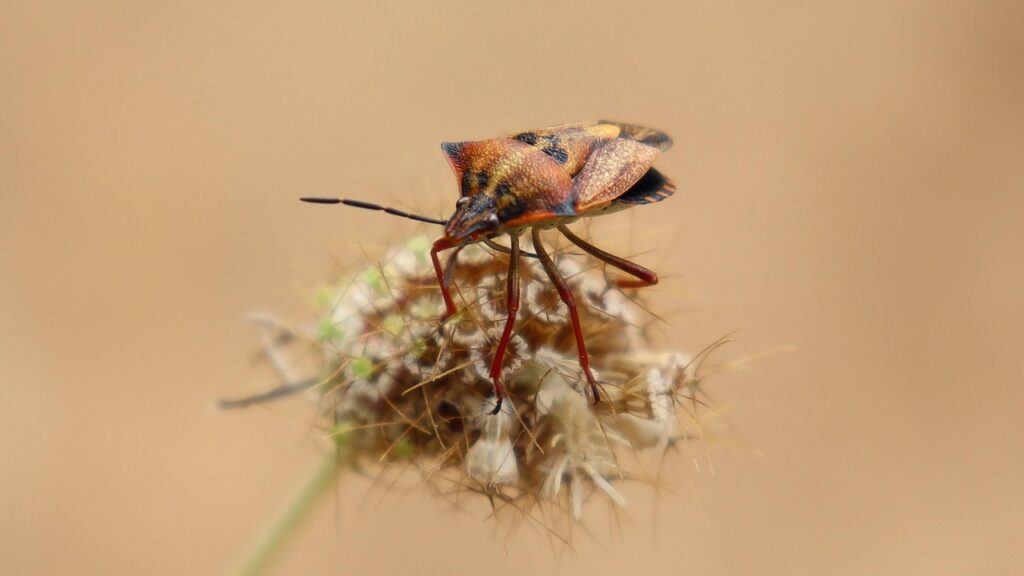
The assassin bug (Reduviidae family) earns its macabre name through its ruthless hunting tactics, but one species takes gruesome behavior to new heights. The aptly named “corpse carrier” assassin bug doesn’t just kill its prey—it creates a psychological weapon from their remains. After draining victims of their bodily fluids using piercing mouthparts, this cunning predator attaches the empty husks to its back using a sticky secretion, creating a grotesque shield of corpses. This backpack of bug carcasses serves multiple purposes: it provides physical protection, camouflage from predators, and may even confuse potential prey until it’s too late. These remarkable insects can be found throughout tropical regions of South America, particularly in Brazil and Peru, where they lurk in forest undergrowth waiting for unwary victims.
The Helmeted Cockroach That Bounces Like a Ball
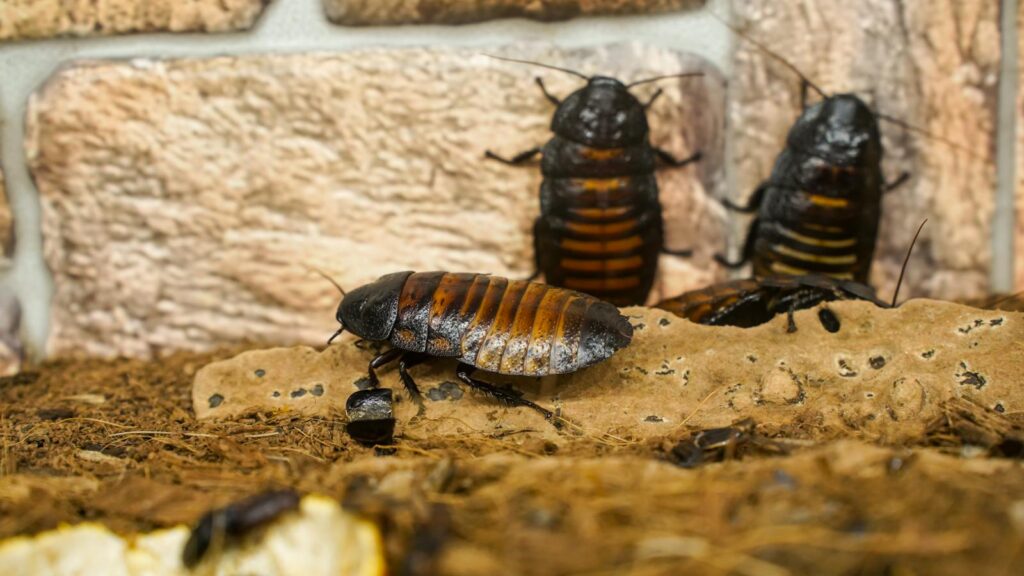
Madagascar’s forests harbor one of the oddest escape artists in the insect world—the helmeted cockroach (Gromphadorhina oblongonota). Unlike its scurrying cousins that infest human dwellings, this peculiar roach has evolved a uniquely acrobatic escape mechanism. When threatened, it tucks in its legs and antennae, forming a perfect ball shape, then launches itself down hillsides by repeatedly bouncing like a rubber ball. This bizarre behavior allows it to rapidly escape danger while its armored exoskeleton protects it from damage during its tumbling descent. The helmeted roach grows up to three inches long with a distinctive dome-shaped head that contributes to its rolling capabilities. Visitors to Madagascar’s eastern rainforests might glimpse these insects during nighttime hikes, though their rolling escape is so rapid that many observers only catch a fleeting glimpse before the roach disappears downslope.
The Thorn Bug with a Deadly Crown
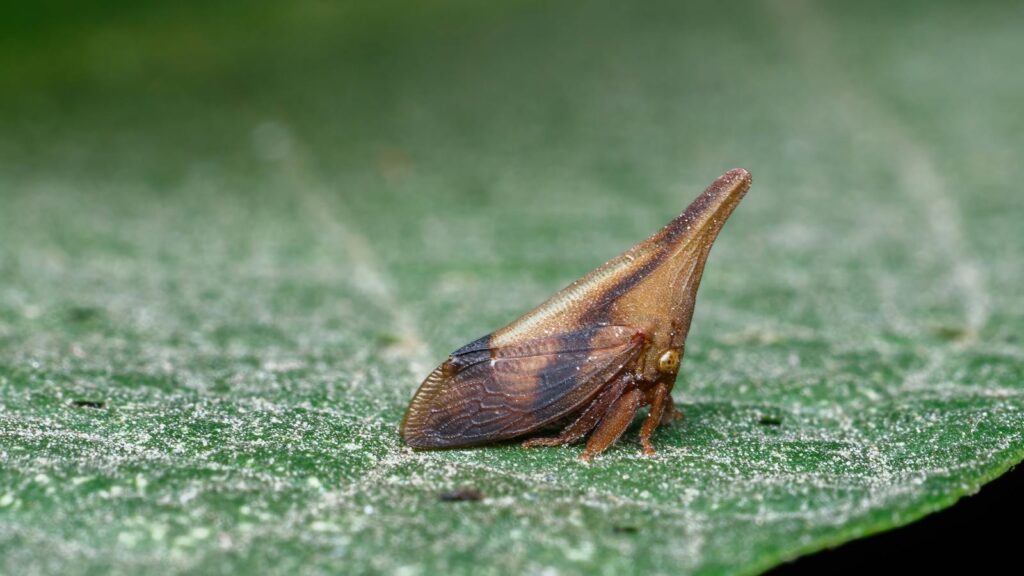
At first glance, the thorn bug (Umbonia crassicornis) appears to be nothing more than a sharp spine growing from a plant stem—which is precisely the point. This masterful mimic sports an enlarged thorax that extends upward into a thorn-like projection, often colored green with red or yellow markings to perfectly match the plants where it feeds. The deception is so complete that predatory birds often avoid these bugs for fear of injuring their beaks on what appears to be a painful thorn. Thorn bugs are sap-feeders that extract nutrients from plant tissues while remaining virtually invisible to predators thanks to their remarkable camouflage. These fascinating creatures can be found throughout Central America and the southern United States, particularly in Florida, where they gather in groups on the stems of acacia trees, mimosa, and other woody plants with natural thorns.
The Giraffe Weevil with an Impossible Neck
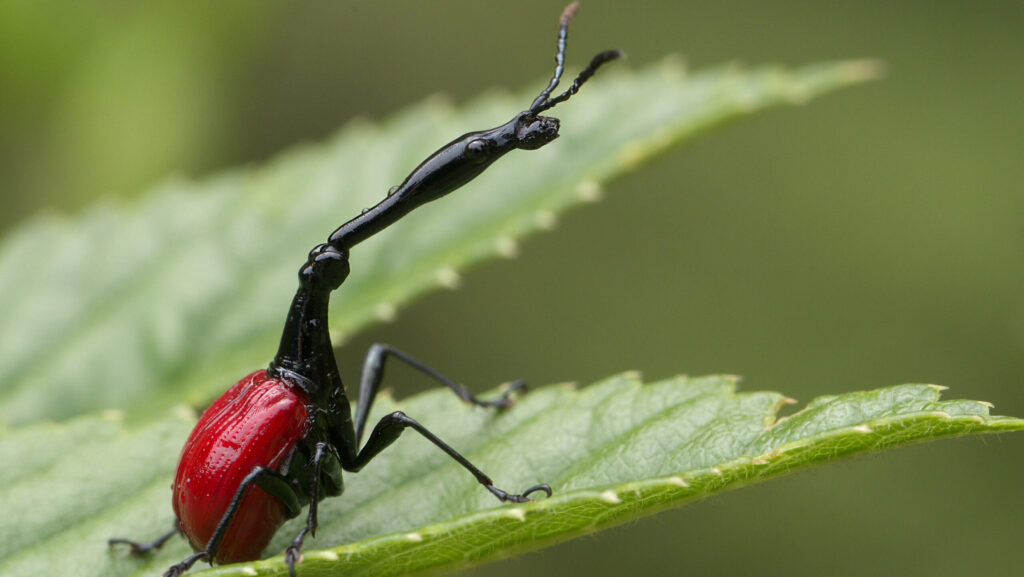
Madagascar’s forests are home to the giraffe weevil (Trachelophorus giraffa), an insect with proportions that seem anatomically impossible. Males of this species possess an extraordinarily elongated neck that can measure up to three times the length of their body—an adaptation that serves a very specific purpose in their reproductive strategy. The extended neck provides leverage during mating competitions, where males wrestle each other to win access to females. After mating, females use their slightly shorter but still impressive necks to roll perfect leaf cylinders where they lay their eggs, carefully folding and tucking the leaf into an architectural masterpiece that protects their offspring. With their bright red wings contrasting against their black bodies and necks, these beetles are relatively easy to spot on the host plants of the Melastomataceae family in Madagascar’s eastern rainforests, particularly during their breeding season from October to December.
The Lacewing Larva That Wears Garbage
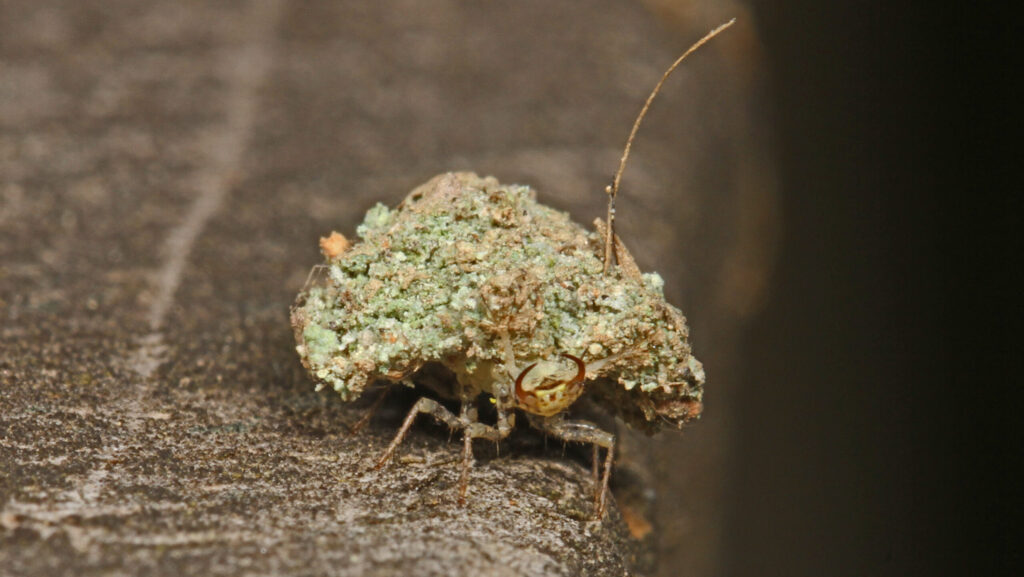
Perhaps one of the strangest defensive strategies in the insect world belongs to the larvae of the green lacewing (Chrysopidae family). These predatory juveniles, often called “trash bugs” or “junk bugs,” create a bizarre form of mobile camouflage by decorating themselves with debris. Using specialized hooked bristles on their backs, they meticulously attach a collection of materials including bits of lichen, small leaves, sand grains, and most disturbingly, the desiccated corpses of their victims. This macabre disguise serves multiple purposes: it camouflages them from predators, shields them from aggressive prey, and may even mask their scent from potential threats. Despite their fearsome appearance, adult lacewings transform into delicate, beneficial insects with translucent wings that consume pest insects in gardens. These peculiar larvae can be found worldwide in gardens, forests, and agricultural areas where they hunt aphids and other soft-bodied insects—just look for small piles of debris that mysteriously move across plant surfaces.
The Malaysian Jungle Nymph That Defies Size Limitations
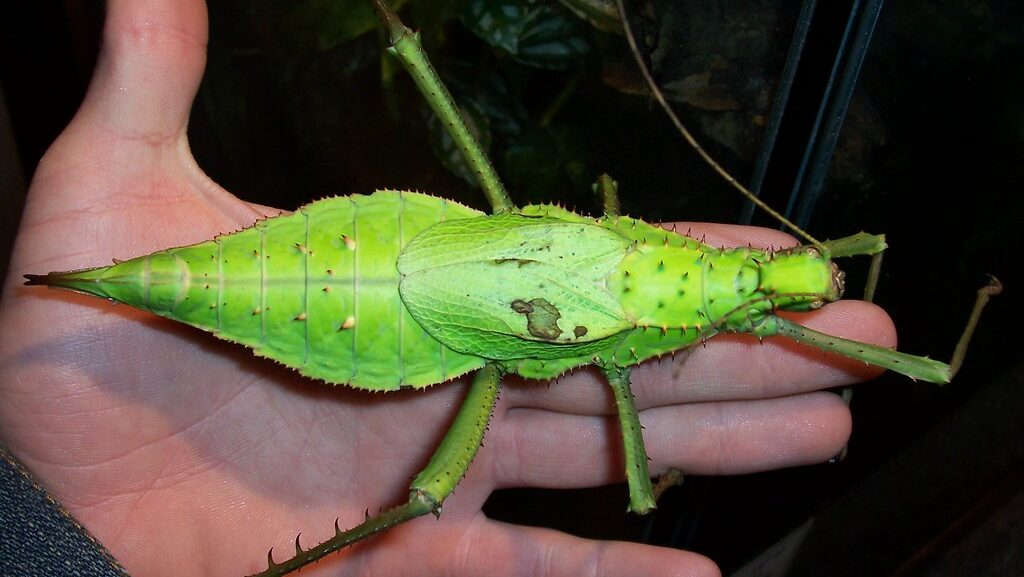
The Malaysian jungle nymph (Heteropteryx dilatata) challenges our perception of how large an insect can grow. Females of this species are among the heaviest insects on Earth, reaching weights of up to 65 grams with bodies extending over 8 inches when legs are included. Their robust, leaf-like bodies are a perfect camouflage in the rainforest canopy, where they feed on foliage while remaining virtually invisible despite their enormous size. What makes these insects particularly unusual is the extreme sexual dimorphism—while females are bulky, wingless, and bright green, males are slender, fully winged, and brownish, appearing more like typical stick insects. This remarkable size difference between sexes is among the most extreme in the insect world. Adventurous bug enthusiasts can search for these giants in the rainforests of Malaysia and Borneo, particularly in Taman Negara National Park, where they reside high in the forest canopy.
The Lantern Fly with a Ghostly Head
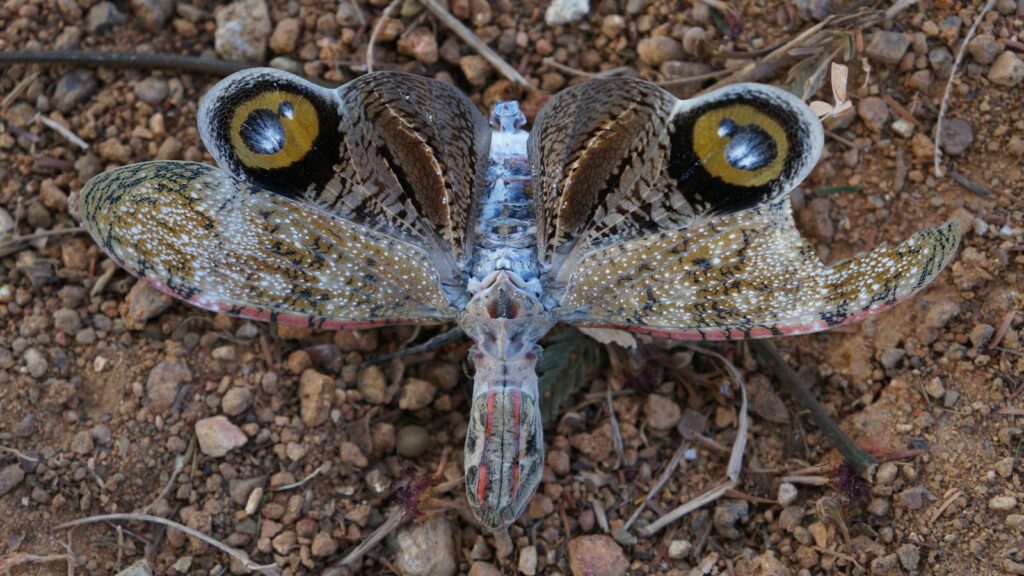
The lantern fly (Fulgora laternaria) of South American rainforests sports one of the most bizarre head structures in the insect world—a hollow, peanut-shaped protrusion that ancient observers once believed could glow in the dark (hence the name, though they don’t actually produce light). This peculiar headgear serves a startling purpose: when viewed from certain angles, it creates an uncanny resemblance to the head of a small alligator or caiman, complete with realistic-looking “eyes” and textured “skin.” When threatened, the lantern fly pivots to present this false head to predators, sometimes enhancing the illusion by rocking back and forth to mimic an aggressive reptile. The deception is further enhanced when the insect reveals its large hindwings, which display vivid eyespots resembling those of an owl or large mammal. These remarkable mimics can be spotted in the Amazon Basin rainforests, particularly in Peru, Brazil, and Ecuador, where they rest on tree trunks during the day.
The Spiny Devil Katydid That Rivals Modern Weapons
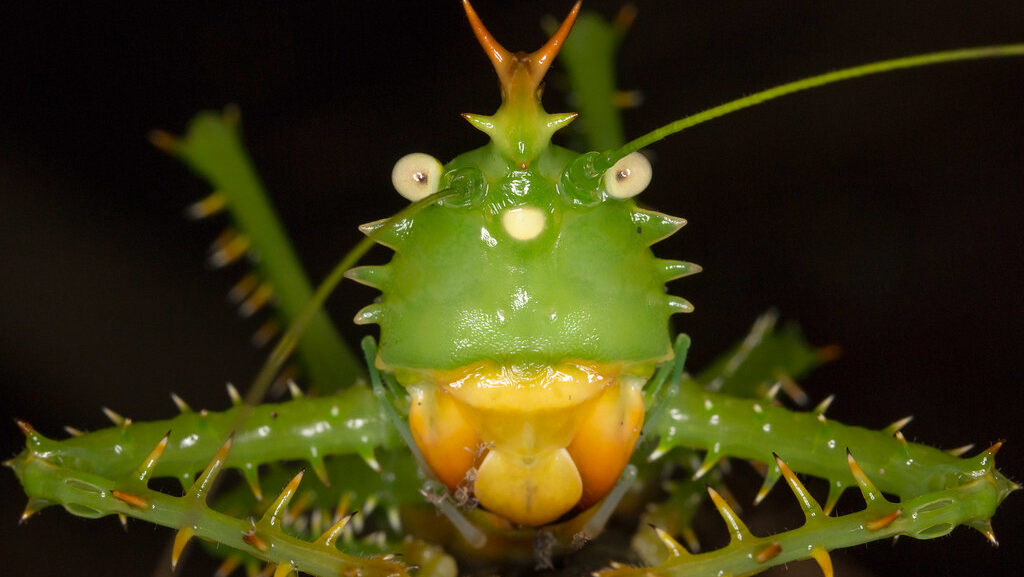
The spiny devil katydid (Panacanthus cuspidatus) from South American rainforests resembles a walking arsenal of biological weapons. Its body is covered with sharp, dagger-like spines that project in all directions from its thorax, legs, and head, making it one of the most heavily armored insects on the planet. These formidable defenses are complemented by powerful mandibles capable of delivering a painful bite to anything that manages to navigate past the spiny exterior. The katydid’s intimidating appearance is enhanced by its coloration—typically bright greens and yellows with contrasting black spines that serve as warning coloration to potential predators. Despite their fearsome appearance, these insects are primarily herbivores that feed on leaves and fruits in the forest canopy. Entomology enthusiasts can find these remarkable creatures in the cloud forests of Ecuador, Colombia, and Peru, where they’re most active at night and can sometimes be located by following their distinctive loud calls.
The Scorpionfly with a Scorpion’s Tail and a Bird’s Head
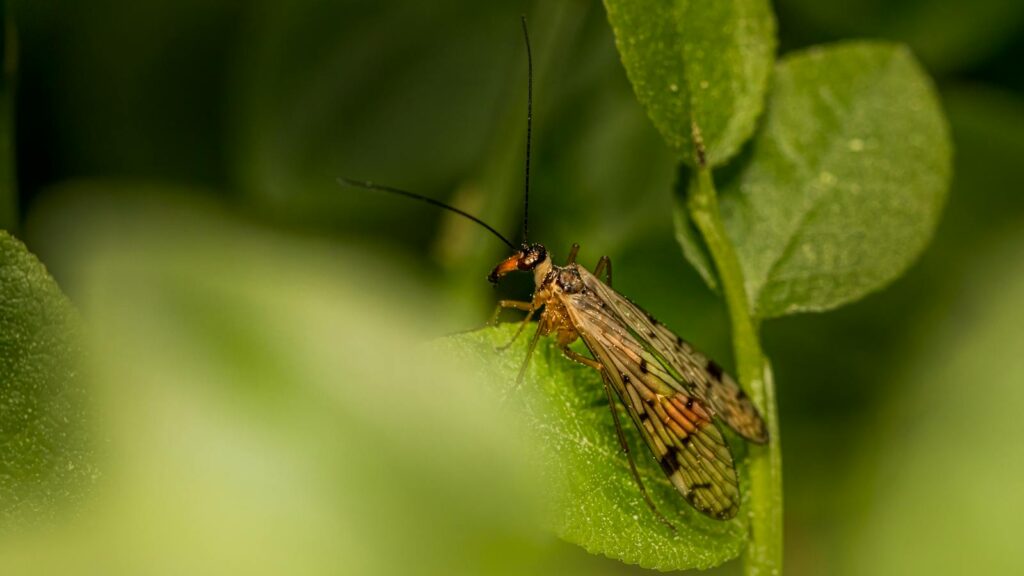
The male scorpionfly (Panorpa species) features one of the most unusual combinations of anatomical features in the insect world. Despite its name and appearance, it’s neither a true fly nor a scorpion, but rather belongs to its own order, Mecoptera. The males possess a bulbous, upturned genital segment that strongly resembles a scorpion’s stinger—a purely harmless structure used for mating rather than defense. Adding to their alien appearance, scorpionflies have an elongated “beak” or rostrum that bears an uncanny resemblance to a bird’s head when viewed from certain angles. These strange insects are actually beneficial scavengers that feed primarily on dead insects and occasionally nectar or fruit. Scorpionflies can be found worldwide in moist woodland habitats, particularly in North America, Europe, and Asia, where they’re most active during warm summer months near streams and in areas with dense undergrowth.
The Mantidfly That Evolved Convergently

The mantidfly (Mantispidae family) represents one of evolution’s most remarkable examples of convergent evolution—where unrelated organisms independently evolve similar features. Despite having no close relationship to either mantids or flies, these insects possess the characteristic raptorial forelegs of a praying mantis combined with the wings and body structure reminiscent of lacewings. This extraordinary case of evolutionary convergence allows mantidflies to be highly effective ambush predators that seize small insects with their powerful front legs. What makes these insects even more unusual is their parasitic larval stage—the juveniles seek out spider egg sacs where they consume the eggs while developing. Adult mantidflies can be found worldwide in tropical and temperate regions, particularly in North America, Australia, and parts of Europe, where they typically hunt on vegetation during warm summer nights and can occasionally be attracted to lights.
The Diabolical Ironclad Beetle That Can Survive Being Run Over
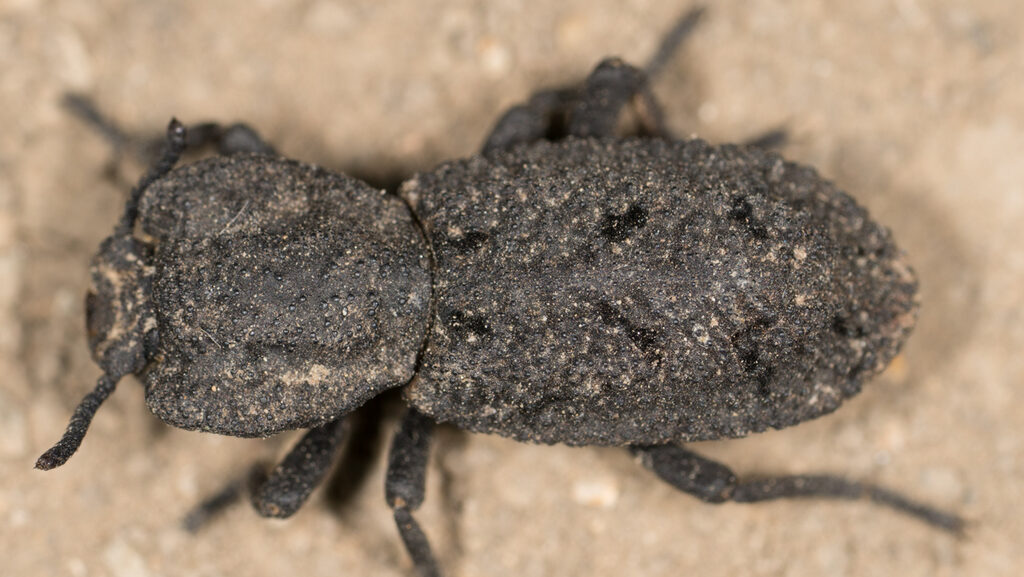
The diabolical ironclad beetle (Phloeodes diabolicus) possesses an exoskeleton so incredibly tough that it can withstand forces up to 39,000 times its body weight—the equivalent of a human surviving the weight of several full-sized school buses. This extraordinary durability comes from specialized connections between the two halves of its shell that function like elaborate jigsaw puzzle pieces, allowing the sections to interlock while absorbing tremendous pressure without shattering. Scientists have studied this beetle’s armor for inspiration in designing more durable aircraft connections and impact-resistant materials. The beetle’s survival strategy involves playing dead when threatened, relying on its nearly indestructible shell rather than fleeing from danger—it can even survive being run over by many vehicles. These remarkable insects can be found in oak woodlands along the western coast of North America, from Southern California into Mexico, where they feed on fungi growing beneath tree bark.
The Ant-Decapitating Fly with Alien Reproduction
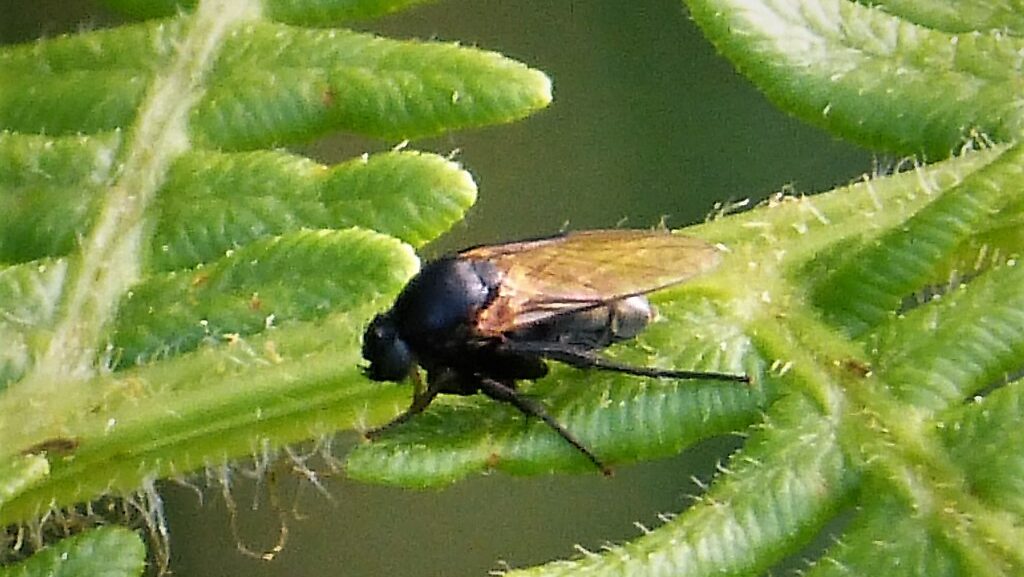
The ant-decapitating fly (Pseudacteon genus) employs one of the most horrific reproductive strategies in the natural world. These tiny flies, barely visible to the naked eye, target specific ant species with surgical precision, injecting a single egg into an ant’s thorax using a specialized ovipositor. What happens next seems drawn from science fiction horror: the larva migrates to the ant’s head, where it consumes the brain and manipulates the host’s behavior, causing it to wander away from the colony. In the final gruesome stage, the larva releases enzymes that dissolve the connections between the ant’s head and body, literally decapitating it from the inside. The fly larva then uses the hollow ant head as a pupal case, eventually emerging as an adult fly through the ant’s mouth opening. These flies are particularly abundant in South and Central America but have been introduced to the southern United States as biological control agents for invasive fire ants, where they can be observed hovering over ant colonies during warmer months.
The Planthopper Nymph with Gear Mechanics
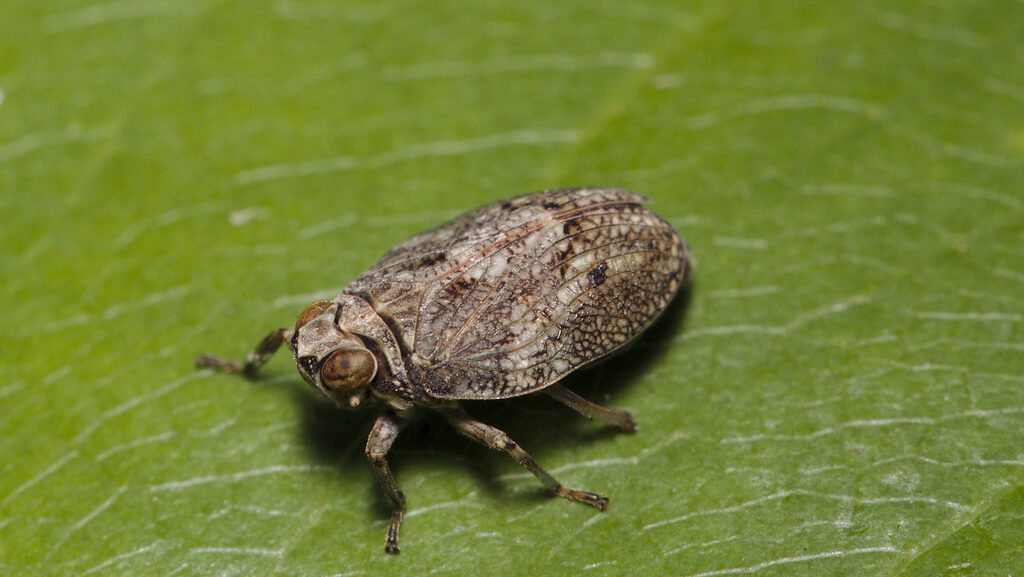
The nymphs of the planthopper (Issus coleoptratus) became famous in scientific circles when researchers discovered they possess the first known functional gears in nature. Located on their hind legs, these microscopic, interlocking gear teeth synchronize the insect’s jumping legs with remarkable precision, ensuring both legs push off the ground within 30 microseconds of each other—faster than neural signals could coordinate. This mechanical synchronization prevents the insect from spinning out of control during its lightning-fast jumps, which accelerate at nearly 400 g-forces. Surprisingly, the nymphs lose these gears when they molt into adults, switching to a friction-based system that’s less efficient but self-healing. Beyond their remarkable mechanical adaptations, these nymphs also sport unusual waxy filaments that give them a fluffy, cotton-like appearance, providing both camouflage and protection from predators. Planthopper nymphs can be found throughout Europe and parts of North Africa, typically on oak, hazel, and ivy plants where they feed on sap with their specialized piercing mouthparts.
The insect world continues to surprise and amaze those willing to look closely at its smallest inhabitants. These extraordinary creatures demonstrate that evolution’s creativity far exceeds our imagination, producing adaptations that engineers and scientists still study for inspiration. From mechanical gears and nearly indestructible armor to parasitic lifecycles that seem alien, insects have developed solutions to life’s challenges that often defy our expectations of what’s possible in nature. The next time you’re in a forest, garden, or even your own backyard, remember that extraordinary evolutionary marvels may be just inches away, waiting to be discovered by curious observers willing to enter their miniature world.

